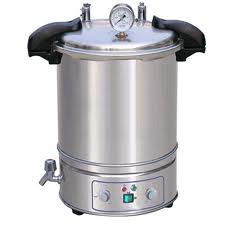Autoclave

An autoclave functions as a device utilized for sterilizing equipment and
supplies by subjecting them to high-pressure saturated steam at 121 °C for
approximately 15–20 minutes, depending on the load size and contents.
Charles Chamberland invented it in 1879, though a precursor known as the
steam digester was developed by Denis Papin in 1679. Its name originates
from Greek auto-, meaning self, and Latin clavis, meaning key, referring to
its self-locking mechanism. Autoclaves find extensive use across
microbiology, medicine, tattooing, body piercing, veterinary science,
mycology, dentistry, chiropody, and prosthetics fabrication, varying in size
and function based on the sterilization requirements.
Typical loads for autoclaves encompass laboratory glassware, surgical
instruments, medical waste, patient care utensils, animal cage bedding, and
lysogeny broth. An increasingly significant application of autoclaves
involves the pre-disposal treatment and sterilization of waste material,
particularly pathogenic hospital waste. Machines in this category typically
operate on similar principles to conventional autoclaves, neutralizing
potentially infectious agents using pressurized steam and superheated water.
A new generation of waste converters achieves the same effect without a
pressure vessel, sterilizing culture media, rubber materials, gowns,
dressings, gloves, etc. This method is particularly beneficial for materials
intolerant to the higher temperatures of hot air ovens. Autoclaves are also
commonly employed in curing composites and rubber vulcanization, ensuring
optimal physical properties are consistently attainable. In industries like
aerospace and sailboat manufacturing, autoclaves exceeding 50 feet in length
and over 10 feet in width are utilized.
Proper air removal from the autoclave before activation is crucial, as hot
air is ineffective for achieving sterility. Steam at 134 °C achieves in
three minutes what hot air at 160 °C requires two hours to accomplish.
Methods for air removal include downward displacement (gravity-type), steam
pulsing, vacuum pumps, superatmospheric cycles, and subatmospheric cycles.
A medical autoclave utilizes steam to sterilize equipment and objects,
effectively inactivating bacteria, viruses, fungi, and spores, although
prions associated with diseases like Creutzfeldt-Jakob may not be destroyed
at typical autoclave temperatures. Autoclaves are prevalent in medical
settings, laboratories, and other environments requiring sterility
assurance. While many procedures now employ single-use items, autoclaves are
still essential for sterilizing medical waste before disposal.
Autoclaving is not suitable for heat-labile products or those susceptible to
steam damage. Additionally, proper separation of items inside the autoclave
is necessary to ensure uniform steam penetration. Chemical, physical, and
biological indicators are employed to confirm autoclave effectiveness, with
computer-controlled autoclaves utilizing F0 values to regulate sterilization
cycles based on time and temperature.
undo Medical Equipment